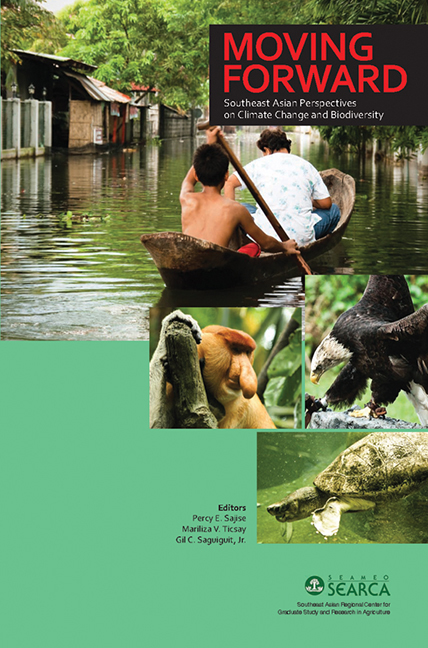12 - Biodiversity and Climate Change: Perspectives, Research Needs, and Institutions
from CHALLENGES AND FUTURE ACTIONS
Published online by Cambridge University Press: 21 October 2015
Summary
TRENDS AND IMPLICATIONS
Climate change is no longer a prediction or a speculation. It is already taking place in many places around the world including Southeast Asia. Long-term data on temperature and sea levels in an archipelagic country like the Philippines, and a partly continental country like Thailand and Vietnam, as reported in the chapters on country perspectives, indicate an increasing trend over the years.
Precipitation patterns are less consistently perceived as increasing or decreasing in particular areas. A more worrisome concern is that the rate of change in climate may be faster than predicted, and the time to develop mitigating and adaptive strategies are running short as extreme weather conditions, associated with these changes, are becoming more prevalent.
Another dimension of this change is the element of scale, both in time and space, which needs to be understood more accurately in order for society to be adequately prepared to deal with the myriad of implications on both the social and natural components of the environment. For example, in a cross- cutting paper in this book, the concept of sustainagility, as a complement or even a form of sustainable strategy, was advanced. How will this take place? Under what conditions will sustainagility be adopted as a social and biological coping strategy for climate change?
The importance of biodiversity maintenance and deployment, as being both an adaptive and mitigation strategy for climate change, was proposed, and evidences were provided. At the same time, the negative impacts of climate change on biodiversity is a major threat which need to be seriously considered in formulating a local, national, regional, and global plan of action for coping with climate change.
The various chapters in this book also highlight the element of interconnectedness. The interconnectedness of the social parameters of poverty, loss of biodiversity, economy, and the increasing vulnerability to climate change; the interconnectedness of ecosystems in the landscape and the need for a holistic view and analysis of the various relationships between social and natural elements, which is needed to better understand the relationships between biodiversity and climate change;
- Type
- Chapter
- Information
- Moving ForwardSoutheast Asian Perspectives on Climate Change and Biodiversity, pp. 231 - 254Publisher: ISEAS–Yusof Ishak InstitutePrint publication year: 2010



